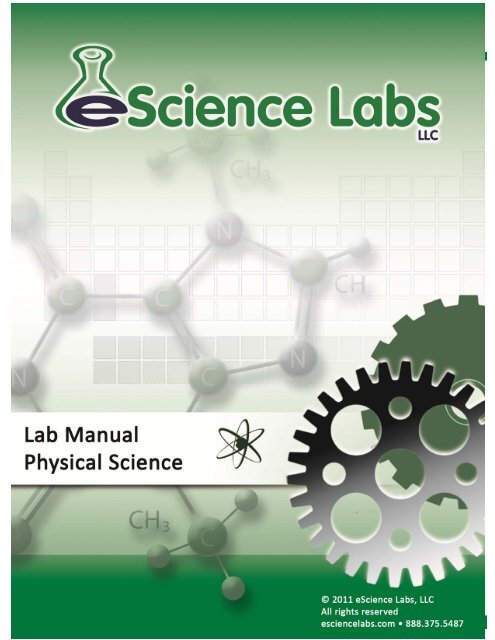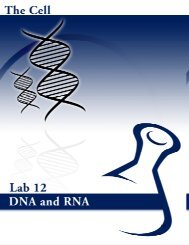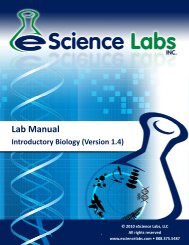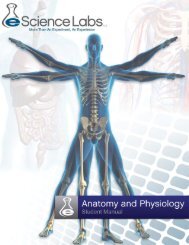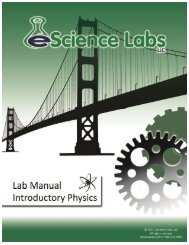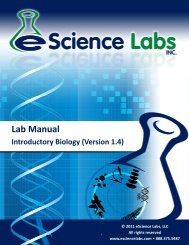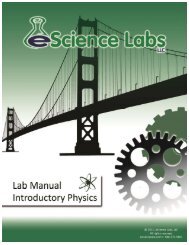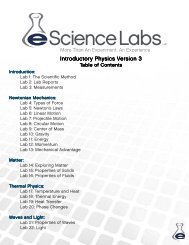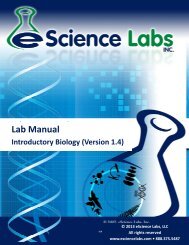Lab 5: Molecular Models - eScience Labs
Lab 5: Molecular Models - eScience Labs
Lab 5: Molecular Models - eScience Labs
Create successful ePaper yourself
Turn your PDF publications into a flip-book with our unique Google optimized e-Paper software.
Table of Contents
Table of ContentsIntroduction<strong>Lab</strong> 1: The Scientific Method<strong>Lab</strong> 2: <strong>Lab</strong> Reports<strong>Lab</strong> 3: MeasurementsChemical Reactions<strong>Lab</strong> 4: Electron Configuration<strong>Lab</strong> 5: <strong>Molecular</strong> <strong>Models</strong><strong>Lab</strong> 6: Chemical ReactionsForce and Motion<strong>Lab</strong> 7: Types of Forces<strong>Lab</strong> 8: Newton’s Laws<strong>Lab</strong> 9: Linear MotionEnergy<strong>Lab</strong> 10: Energy<strong>Lab</strong> 11: Temperature and Heat<strong>Lab</strong> 12: Properties of WavesPhysical Science3
<strong>Lab</strong> 5: <strong>Molecular</strong> <strong>Models</strong>
<strong>Lab</strong> 5: <strong>Molecular</strong> <strong>Models</strong>1. Bring together the same poles of twobar magnets.2. Observe and describe what happens.3. Explore the linear shape of moleculesby bringing the same poles as closetogether as you can in a straight line.Record your observations in the Datasection.4. Explore why a molecule makes atrigonal planar shape by placing thesame pole of 3 bar magnets as thepoints of an equilateral triangle withthe rest of the magnet behind them.5. Slowly bring the same pole of the 3magnets as close as it is possiblewhile maintaining the equilateralFigure 4: Magnet setup for experiment Procedure 1.triangular appearance. Now try tofind another shape that will be asstable with all of the magnets at leastas close as they were in the equilateral triangle position. Record your observations inTable 3.DataTable 3: Observations for Procedure 1Procedure StepObservationsStep 1Step 2Step 351
<strong>Lab</strong> 5: <strong>Molecular</strong> <strong>Models</strong>Table 4: Observations and data for Procedure 2<strong>Molecular</strong> Shape Observations Bond AngleLinear (2 atoms)Linear (3 atoms)Trigonal PlanarBentTrigonal PyramidalTetrahedralTrigonal BipyramidalOctahedral52
<strong>Lab</strong> 5: <strong>Molecular</strong> <strong>Models</strong>Post‐lab Questions1. In Part 2 of the procedure, did your models fit the molecular shape description or matchthe geometry in the introduction? Explain why or why not.2. Predict the shapes and bond angles of the following molecules:a. BeCl 2b. BH 3c. CBr 453
<strong>eScience</strong> <strong>Lab</strong>s, LLC1500 West Hampden AvenueBuilding 2Sheridan, CO 80110303.741.0674 • www.esciencelabs.com


